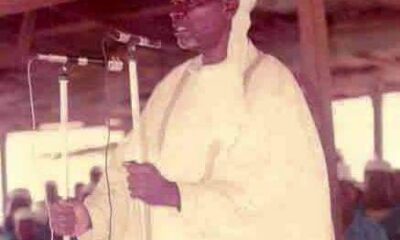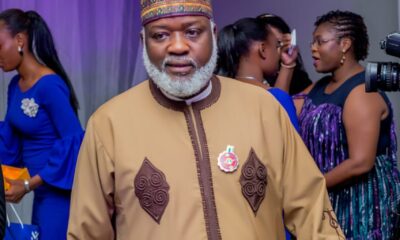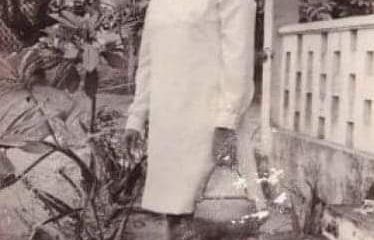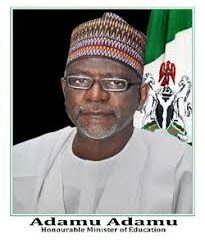Opinion
The Progress Needed For Connecting The Unconnected-Y.Z Ya’u
Opinion
Debunking the Myth of Christian Genocide in Nigeria: Unmasking America’s Militarism and Invasion Tactics
By Sani Khamees
In 2017, while serving in Kano through the National Youth Service Corps (NYSC) scheme in Nigeria, I crossed paths once more with Professor Horace Campbell. An invitation arrived at the department of Political Science, Aminu Kano College of Islamic and Legal Studies, summoning us to hear Campbell speak on his latest book, ‘Global NATO and Catastrophic Failure in Libya: Lessons for Africa in the forging of African unity.’ I shared with my HOD that I had first met Campbell in 2010, during his condolence visit for the late Dr Tajudeen Abdulraheem, my former school director in Funtua. My HOD eagerly accepted, and we prepared for the evening. After introducing myself to Campbell, he handed me his book and asked for a summary. His work reveals how Western powers, under the banner of NATO, used the UN Security Council’s Resolution 1973 and the so-called ‘responsibility to protect’ as a pretext to invade and devastate Libya (Campbell,2013).
The Libyan uprisings emerged from the Arab Spring, which began in Tunisia in 2010 and spread across Egypt, Yemen, Syria, Bahrain, and finally Libya. After Tunisia’s Bin Ali fled and Egypt’s Mubarak was toppled by a tidal wave of revolution, Benghazi erupted in rebellion just days later. But the West soon intervened, transforming a popular movement into an armed struggle. In response, Gaddafi threatened to unleash the full force of the state to crush the discord.
By February 21, 2011, Western media had rewritten the story, claiming that innocent civilians faced imminent massacre by the Libyan army. Headlines like “Gaddafi Warns of ‘Rivers of Blood’ as UN Prepares to Vote” from The Guardian and reports from CNN suggesting the urgent need for intervention due to potential atrocities influenced public perception. The United States, Britain, and France seized the moment, pushing a UN Security Council resolution under the guise of ‘responsibility to protect.’ This cleared their path into Libya, leading to Gaddafi’s death and the takeover of the nation’s political and economic future.
In the aftermath of Libya’s collapse, chaos swept across the Sahel as militias like Boko Haram, Jama’at Nusrat ul-Islam wa al-Muslimin (JIMIM), Islamic State in the Greater Sahara (ISGS), Islamic State – West Africa Province (ISWAP), Bandits, and Ansaru surged back into prominence. The collapse led to a vacuum of power and increased availability of weapons when Gaddafi’s vast armory was looted and diffused across the region. These armaments and the instability spurred by Libya’s breakdown facilitated the resurgence and strengthening of militant groups in surrounding areas, including Nigeria. In Nigeria, Boko Haram in the Northeast and Bandits in the Northwest became household names, operating mainly in the country’s northern regions. Boko Haram launched its campaign in Borno State with the rallying cry ‘no to western education’, then spread to Yobe, Gombe, Bauchi, and even Kano, areas with deep Muslim roots. Their reign of terror included bombings of worship centers, hospitals, markets, and busy roads, as well as kidnappings for forced marriage, abuse, and other social vices.
Rivaling Boko Haram in brutality are the armed bandits who first emerged in Zamfara State and quickly spread to Sokoto, Kebbi, Niger, and Katsina, now encroaching on the north-central states of Plateau, Benue, and Kwara. Unlike Boko Haram, these bandits are driven by profit, engaging in kidnappings for ransom, assaults on villages and towns, and the deliberate killing of civilians.
Both Boko Haram and the armed bandits have left a trail of devastation: thousands of civilians killed, worship centers and farmlands destroyed, and entire villages emptied as people flee for safety. Their violence knows no boundaries of religion, tribe, or ethnicity. Boko Haram has bombed mosques, including the Kano city mosque near the Emir’s palace, killing over 120 and injuring around 200. (wikipedia, 2014) Bandits have kidnapped thousands and indiscriminately attacked travelers and villagers. Their latest atrocity saw worshippers in Mantau village, Malumfashi, gunned down during dawn prayers.
It is a fact that most terror attacks in Nigeria occur in the Muslim-majority north. While these groups show no regard for religion or ethnicity, it is the Muslim population that suffers most, simply because they are the majority. However, the narrative of a targeted genocide against Christians fails to hold when we incorporate the experiences of both Muslim and Christian communities in the north. According to a report by the International Crisis Group, the majority of attacks and incidents of violence between 2010 and 2019 occurred in northern regions, with Muslim communities being disproportionately affected. Studies also suggest that around 8 out of 10 victims of Boko Haram’s attacks are Muslims (Group, 2010). Testimonies from these communities reveal a shared struggle against violence and a mutual rejection of divisive labels imposed from outside. A Muslim community leader from Maiduguri described a neighborhood where Christians and Muslims live side by side, united in their fear and condemnation of extremist violence. Similarly, a Christian resident of Kaduna expressed that they view their Muslim neighbors as partners in resilience rather than adversaries. Such perspectives challenge simplistic genocide narratives and highlight how local identities and solidarities complicate the external binary framing of conflict in Nigeria.
Echoing the tactics used to justify intervention in Libya, a recent claim by American politician Bill Maher alleges that Christians in Nigeria are being targeted for genocide. He asserts that Islamists have killed over 100,000 Christians and destroyed 18,000 churches, painting a picture of a systematic campaign to erase Christianity from Nigeria. These claims are fabrications, designed to set the stage for another ‘responsibility to protect’ intervention. Nigeria’s wealth in natural resources and oil has long made it a target for Western interests.
It is clear that the US seeks to repeat the Libyan scenario in Nigeria. Western media excels at crafting divisive narratives that pave the way for imperial ambitions. This pattern is not new. Samir Amin, in ‘The Liberal Virus: Permanent War and the Americanization of the World,’ describes how Hitler used the Reichstag fire as a ploy for repression, drawing parallels to George Bush’s invasion of Iraq and NATO’s intervention in Libya (Amin, 2004). Now, the same playbook is being opened for Nigeria.
However, it is crucial to recognize the active role Nigerian actors, both in person and groups, play in countering these narratives and steering their own destiny. The Nigerian government has engaged in diplomatic dialogues and sought the support of international bodies to challenge misleading accounts and protect the country’s sovereignty.
Additionally, vibrant civil society organizations in Nigeria work tirelessly to foster inter-communal dialogue and resist attempts to sow discord. Nigerian media outlets, both traditional and digital, have amplified local voices and stories that underline a unified resistance against manipulative foreign interests. These efforts highlight Nigeria’s agency in shaping its future and resisting external exploitation.
Sani Khamees is a community activist and Pan-Africanist from Funtua, Katsina state of Nigeria.
Facebook: SaniKhamees@facebook.com
Twitter (X): @Khamees _sa54571
References
Campbell, H (2013). Global NATO and Catastrophic Failure in Libya: Lessons for Africa in the forging of African unity. New York, Monthly Review Press
Amin, S. (2004). The Liberal Virus: Permanent War and the Americanization of the World. Monthly Review Press. https://nyupress.org/9781583671078/the-liberal-virus/
(2014). 2014 Kano attack. https://en.wikipedia.org/wiki/2014_Kano_attack
Group, I. C. (2010). Northern Nigeria: Background to Conflict. International Crisis Group. https://ciaotest.cc.columbia.edu/wps/icg/0020843/index.html
Amin, S. (2004). The Liberal Virus: Permanent War and the Americanization of the World. Monthly Review Press. https://nyupress.org/9781583671078/the-liberal-virus/
(2020). 90% of Boko Haram’s victims are Muslims — Buhari. https://www.vanguardngr.com/2020/02/90-of-boko-harams-victims-are-muslims-buhari/
Opinion
Kaduna State: A Phoenix Rising from the Ashes of Insecurity and Politics” By Zubair Abdurrauf Idris
Despite the maelstrom of criticism and political backlash that has engulfed Kaduna state’s governance under Governor Uba Sani, the latest indices of easing business by the Nigerian Presidential Council PEBEC have catapulted the state to the pole position, nipping at the heels of Lagos state. This stunning revelation has sent shockwaves across the nation, with many wondering how Kaduna state managed to turn the corner and emerge as a beacon of hope in the region.
The “Ease of Doing Business” report has ranked Kaduna state a respectable second, with an impressive score of 65.1%, trailing only Lagos state, which boasts an enviable 85.6%. The other contenders, Oyo State, Federal Capital Territory (FCT), and Ogun State, have been relegated to third, fourth, and fifth positions, with scores of 62.7%, 61.0%, and 59.9%, respectively. This remarkable turnaround is a testament to the state’s resilience and determination to rise above the challenges that have held it back for so long.
This remarkable turnaround is a blessing in disguise, considering the dark days of insecurity that once shrouded Kaduna state like a pall. The state was previously ravaged by armed banditry and kidnappings, which had sent investors packing and crippled economic activity. However, thanks to the recent community-based peace deal, the frontline local government areas have been able to breathe a sigh of relief, and the state’s economic prospects are looking brighter than ever.
Kaduna state’s journey to this point has not been without its challenges. The state has been mired in political logjam and accusations, with the former administration casting a long shadow over the current government’s efforts. However, the “Ease of Doing Business” report is a vindication of Governor Uba Sani’s tireless efforts to woo foreign investors and create a conducive business environment. The governor’s recent trip to Kuwait, which resulted in a grant of $63 million for out-of-school children, teacher training, and rehabilitation of classrooms, is a case in point.
While some critics have dismissed the governor’s foreign trips as globe-trotting, the positive results are beginning to trickle in, and they are a testament to the governor’s unwavering commitment to improving the lives of Kaduna state residents. The improved security, coupled with the government’s focus on industrialization, economic development, and infrastructure, is expected to have a multiplier effect on the state’s economy, creating jobs, stimulating growth, and enhancing the overall quality of life for citizens.
As Kaduna state continues to navigate the complex web of challenges and opportunities, it is imperative that the government remains focused on consolidating the gains made so far. The state must continue to implore all its arsenal to maintain the fragile peace, ensure free movement, and create an enabling environment for businesses to thrive. If the current trajectory is anything to go by, Kaduna state is poised to become the next big thing in Nigeria’s economic landscape, a shining example of what can be achieved with vision, determination, and a commitment to progress.
(Zubair Abdurrauf Idris is a public affairs analyst, wrote from Birnin-Gwari)
Opinion
Re:Replace Ribadu With Ex- military Officer As NSA,Senator Urges Tinubu
Henry Bassey
As a concerned citizen of Nigeria and someone who desire a stable structure in tune with the modern dynamics which will invariably bring about security of lives and property, my attention was drawn to a statement credited to Senator representing Osun East, Distinguished Senator Francis Fadahunsi issued through his Special Adviser on Media, Sam Segun – Progress on Tuesday 2 December 2025 at Osogbo and published in Punch online and other social media platforms including Facebook, Instagram and X (formally Twitter) to mention a few.
In the statement, the lawmaker was urging President Tinubu “to further reorganize the nation’s security management team by appointing a retired military officer as the National Security Adviser. He also advised the President to “redeploy the current NSA Malam Nuhu Ribadu to another area of national service where his competence would be better utilised.”
The call by Senator Fadahunsi for President Bola Ahmed Tinubu to replace Mallam Nuhu Ribadu with a retired military officer as National Security Adviser reflects a narrow view of national security leadership, a dangerous direction of thought inconsistent with global best practices and Nigeria’s security needs, and a comment that should not go unanswered. Rather than distracting the nation with unnecessary politicization of security appointments, leaders should support efforts already succeeding to strengthen intelligence gathering, improve operational synergy, and pursue lasting peace across the country. What Nigeria needs is results, not recycled arguments rooted in outdated assumptions.
For a proper understanding, it should be noted that the broad dimensions of national security include physical, political, economic, social, food, energy and environmental aspects, which have expanded beyond traditional military concerns to encompass the gamut of modern threats. These dimensions are interconnected and involve protecting a nation’s citizens, infrastructure, and institutions from internal and external threats, such as cyberattacks, economic shocks, pandemics, and climate change, external aggression, etc. Military means is therefore one among many contributing factors to national security, not its essence. This understanding is fundamental to having the right national security strategy and architecture.
Senator Fadahunsi’s suggestion that the President should replace the NSA with a retired military officer exposes a shallow and outdated understanding of modern national security leadership. The policymakers and security specialists of the United States and other climes, whose style of democracy we practice, have always leveraged this for preserving their national security. Among the many who have held that office in the US in recent times is a civilian lawyer, Jake Sullivan, and his predecessor too was a political scientist-turned-lawyer. Regardless of the difference in context, the fact is that the role has successively been held across the globe by civilians with intellectual understanding of the complex realities that undermine national security. Even here on the African continent, in countries like Egypt, the appointment of non-military security insiders and analysts is a proven practice. Few Nigerians are aware that policemen had been in control of ONSA in the past, serving under both military regimes and civilian administrations. Both Gambo Jimeta, a former Inspector-General of Police, and Aliyu Isma’ila Gwarzo, a retired Assistant Inspector-General of Police (AIG) have served as NSA, and their performance was outstanding because of their recognition of the diverse range of challenges that undermined national security, and their understanding of the relationship between the civilian and military spheres.
What lies at the core of Nigeria’s complex and multifactorial security challenge? Nigerians are bedeviled by internal security collapses that require much more than tanks and other military hardware to combat, without diminishing the need for that. The nation desperately needs ideas and brains to identify the root causes of the conflicts and proffer solutions, hence the need for an NSA who possesses a combination of expertise in statecraft and public policy, mastery of engagement with civilian and military structures, dedication to the nation, as well as experience in internal security and law enforcement, to change the negative security narrative of the country – something that Mallam Ribadu has brought to the table.
Ribadu’s leadership is anchored in deep experience in intelligence, anti-corruption enforcement, inter-agency collaboration and counter-terrorism policy. The NSA is not a combatant position, the unique value they provide is the ability to analyze available information and intelligence to predict the state of security in the nation, hence the critical need for one with an understanding of the socio-cultural and political determinants of conflicts in a country like Nigeria undermined by internal security largely. Today’s security environment demands intelligence, intellectual capacity, integrity and strategic coordination of civilian and military structures, with unwavering patriotism, qualities which Mallam Nuhu Ribadu has demonstrated for decades. He is a square peg in a square hole as the NSA. The idea that only a soldier can manage national security is obsolete.
The notion that only government officials with military backgrounds could command the necessary respect within the armed forces is a dangerous idea to be promoted by anyone in a democracy, and is far from what modern military training delivers to the officers and men of the various services. The proper democratic structure which the military stands ready to uphold and defend, including proper regard for the command of any official appointed by the President and Commander-In-Chief, needs to be reinforced, not weakened as this suggestion by Senator Fadahunsi inadvertently achieves. The role of the NSA will remain suboptimized unless the nation moves away from excessive militarization of the office, particularly for a country where the military is overburdened with taking on responsibilities under the Nigeria Police Force and other internal security agencies.
National security is not all hinged upon and cannot be left to military power and coercion alone, it must enlist the other strengths of our nation to holistically address our challenges, and persuasively engage the world. As a nation we must strengthen the civilian security capabilities we have left to waste for so long. President Bola Ahmed is on track with the appointment of Mallam Nuhu Ribadu and the results that have been delivered so far, this needs only to be sustained for more results in the interest of all Nigerians, and not disrupted by a myopic few.
Henry Bassey,
Former Lagos State Chairman, Police Campaign Against Cultism and Other Vices.
Currently Head Community Engagement, Police Campaign Against Cultism and Other Vices, South West
Email: bassey.henry373@gmail.com
-

 Opinion4 years ago
Opinion4 years agoOn The Kano Flyovers And Public Perception
-

 Features4 years ago
Features4 years agoHow I Became A Multimillionaire In Nigeria – Hadiza Gabon
-

 Opinion5 years ago
Opinion5 years agoKano As future Headquarters Of Poverty In Nigeria
-

 History5 years ago
History5 years agoSheikh Adam Abdullahi Al-Ilory (1917-1992):Nigeria’s Islamic Scholar Who Wrote Over 100 Books And Journals
-

 Opinion4 years ago
Opinion4 years agoMy First Encounter with Nasiru Gawuna, the Humble Deputy Governor
-

 History5 years ago
History5 years agoThe Origin Of “Mammy Market” In Army Barracks (Mammy Ochefu)
-

 History4 years ago
History4 years agoThe History Of Borno State Governor Professor Babagana Umara Zulum
-

 News4 years ago
News4 years agoFederal University Of Technology Babura To Commence Academic Activities September